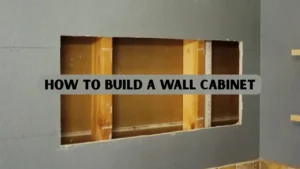A reliable tablesaw outfeed table is one of the most valuable improvements you can make to a woodworking shop. Every woodworker eventually encounters the challenge of managing long boards, wide panels, or heavy sheet goods without proper support behind the saw. A well-built support system ensures that material exiting the blade stays aligned, level, and stable. Without it, boards can tip, drag, or shift as they clear the blade, which affects accuracy and increases safety risks.
A carefully designed support table improves control and reduces strain on the operator. It makes workflow smoother, cuts more predictable, and projects more consistent. Whether you work on furniture, cabinetry, home projects, or general workshop builds, a dependable workstation immediately elevates efficiency. This guide explains how to plan, design, and build a durable support system using proven workshop practices and trusted construction principles.
Key Takeaways
- A tablesaw outfeed table increases safety, improves cut accuracy, and supports long workpieces during woodworking.
- Choosing the right size, materials, and structure ensures a stable and effective work surface.
- Real workshop planning, careful measurements, and sturdy construction create a reliable workbench extension for any saw.
- Adding storage, mobility, and adjustable height options enhances workflow and convenience.
- This guide provides a complete step by step overview including planning, design considerations, safety tips, and solutions to common workshop challenges.
What a Tablesaw Outfeed Table Does in a Woodworking Shop
A support table behind the saw acts as a direct extension of the main cast iron surface. Its purpose is simple and important. As the workpiece passes the blade, the support table carries the weight and keeps the board flat. Without it, the rear of the board can drop, twist, or bind. That instability affects both safety and the quality of the cut. A smooth exit path is essential for consistent woodworking.
Many woodworkers with small shops face challenges when handling long or wide materials. A dedicated support system solves this problem by giving boards a large, flat landing area. It also prevents the awkward moment when an unsupported board suddenly falls off the back of the saw. With proper planning, the workstation often becomes a multifunction surface for layout work, assembly projects, and general shop organization.
Why Every Workshop Benefits From a Support System
Every operation that involves ripping or trimming long boards benefits from stable support. Even smaller cuts become more accurate when the workpiece is fully supported before and after the blade. For woodworking tasks involving cabinets, tabletops, frames, or sheet goods, the value becomes even more noticeable.
Key reasons to install an outfeed solution include:
- Improved safety during rip cuts
- Reduced chance of wood binding against the blade
- Better support for long or wide materials
- Fewer accidental drops or damaged workpieces
- More accurate and cleaner cuts
- Less physical strain during cutting
- Additional workspace for layout and assembly
A well built system brings steady, predictable control to every cut.
Planning the Perfect Tablesaw Outfeed Table
Planning is the foundation of a reliable workstation. The height must match the top of the saw perfectly. Even a small mismatch can cause lifting or catching during cuts. Accurate measurement is essential at this stage.
Key planning considerations include:
- Height alignment with the saw
- Available space behind the saw
- Width and length of the support surface
- Frame material and weight capacity
- Storage options such as shelves or drawers
- Mobility requirements
- Precise placement of the structure within the shop
Planning also includes identifying potential obstacles behind the saw. Power outlets, dust collection lines, doors, walls, and nearby tools can affect how far the workstation extends. Adequate clearance ensures long boards slide naturally without catching against other shop elements.
Choosing Materials That Support Stability and Durability
-
Top Material Options:
-
Plywood: Strong, resists sagging, durable for long-term use.
-
MDF: Heavy, stable, provides a smooth, even surface.
-
Combination: Plywood with a thin hardboard layer creates a smooth, replaceable top.
-
-
Frame Material Options:
-
Lumber (2×4 or 4×4): Dependable and widely available.
-
Steel Frame: Offers maximum rigidity for high-strength setups.
-
-
Structural Considerations:
-
Frame must resist flexing, twisting, and wobbling.
-
Use strong joinery techniques and quality fasteners for durability.
-
Add diagonal bracing to enhance stability.
-
-
Leveling and Adjustment:
-
Adjustable feet allow easy leveling on uneven floors.
-
Ensures the outfeed table aligns perfectly with the table saw surface.
-
Designing a Structure That Fits Your Shop
Designing the workstation requires balancing stability, function, and shop space. In small workshops, builders often include storage drawers or shelves under the surface. These additions make efficient use of space and keep essential tools within reach. Larger workshops may allow for a wide support surface capable of handling full sheets of plywood.
Important design features include:
- A continuous flat surface behind the saw
- A top wide enough to support various material sizes
- A length long enough to prevent workpieces from dropping
- Locking casters or leveling feet
- Clear alignment with the saw’s miter slots
- Optional channels for passing sleds or jigs
Some woodworkers prefer adding miter slot channels to the surface so crosscut sleds can glide across smoothly. Others create a flush surface without channels and rely on a perfectly even transition from saw to outfeed top.
Step by Step Guide
A methodical approach ensures a strong and level outfeed table support structure. Follow these proven steps:
Step 1: Measure the Height
Measure the height from floor to the top of your saw. The workstation surface must match this measurement exactly.
Step 2: Build the Frame
Construct a rigid frame using lumber or steel. Add cross braces to reduce side to side movement and strengthen the unit.
Step 3: Attach the Legs
Secure legs to the frame and confirm stability. Add diagonal supports if the table flexes or moves. Install leveling feet for fine height adjustments.
Step 4: Prepare the Tabletop
Cut the top material to the required width and length. Smooth the edges to avoid splinters while handling material.
Step 5: Mount the Top
Attach the top to the frame using screws. Confirm that the height matches the saw and adjust with the leveling feet as needed.
Step 6: Install Storage Options
Add shelves, drawers, or tool compartments to maximize the usefulness of the space beneath the top.
Step 7: Test the Surface
Slide a long board across the saw onto the table. Ensure the transition feels smooth and level.
Practical Workshop Experience Tips
Working woodworkers often share small improvements that make a support station even more useful:
- A slick top surface helps boards glide more easily
- Heavier tops reduce vibration
- Storage shelves improve organization
- Casters help reposition the workstation for long materials
- Rounded edges reduce chances of catching material
- Light colored surfaces make markings easier to see
These tips improve the everyday operation of the workstation and showcase practical knowledge gained through real shop use.
Safety Considerations When Using the Table
Safety is always essential in a woodworking shop. A well built support table helps maintain safety, but proper cutting techniques remain necessary.
Important safety precautions include:
- Keeping hands away from the blade area
- Maintaining a clear and dust free surface
- Using hearing and eye protection
- Using push sticks or push blocks when cutting narrow boards
- Confirming the table stays level and stable
- Replacing worn casters or leveling feet
Consistent safe habits prevent accidents and support long term woodworking confidence.
Additional Uses Beyond Outfeed Support
Woodworkers often discover their support table becomes one of the most frequently used surfaces in the shop. It can double as:
- An assembly bench
- A sanding station
- A measuring and layout table
- A small project workbench
- A clamping station
- A temporary finishing surface
This versatility is one of the main reasons many builders consider the workstation a central part of the shop.
Maintaining and Upgrading the Workstation
Regular maintenance keeps the workstation sturdy and reliable. Wood can shift, screws can loosen, and surfaces can slowly become uneven.
Maintenance tasks include:
- Checking and tightening screws
- Re leveling the surface
- Replacing worn casters
- Cleaning dust buildup
- Refreshing protective coatings on the top if needed
Upgrades can include adding drawers, lighting, a smoother top layer, or expanding the surface area.
Choosing the Right Size for Your Cutting Needs
Choosing the correct size for your tablesaw outfeed table improves workflow and stability. Builders who frequently cut sheet goods should construct a long and wide surface. Those who work with smaller pieces may prefer a more compact design that fits tight shop spaces.
General guidelines:
- Width equal to or wider than the saw
- Length long enough to support large boards
- Matching height with no variation
- Strong leg spacing
- Minimal surface overhang
The correct size reduces unwanted movement of material and supports steadier cutting operations.
Case Studies
- A small garage workshop added a compact support table and immediately improved sheet handling. The builder reported cleaner cuts and fewer alignment problems during cabinet projects.
- A professional furniture maker built a heavy plywood framed unit with drawers beneath. The additional storage reduced clutter and saved time by keeping layout tools within arm’s reach.
Conclusion
Building a dependable support workstation behind your table saw is one of the most effective upgrades you can add to your shop. It increases safety, accuracy, and workflow efficiency. With proper planning, solid materials, and proven construction techniques, any woodworker can build a reliable support surface that manages long boards and wide panels with confidence.
A well-built tablesaw outfeed table becomes a central part of the shop, doubling as an assembly area, layout bench, and storage surface. With routine maintenance and thoughtful upgrades, it will serve you for many years and enhance nearly every woodworking project you tackle.
FAQ
How high should the outfeed table be?
It must match the height of the table saw surface exactly.
Is MDF or plywood better?
Both are suitable. MDF is smooth and stable while plywood provides strength and screw holding power.
Should the workstation move or stay fixed?
Fixed units work well in large shops, while mobile designs benefit smaller spaces.
Can the table double as an assembly bench?
Yes. Many woodworkers use it for assembly, layout, and sanding.
Should I add miter slots?
Yes, if you use sleds or jigs that need to travel beyond the saw table.




